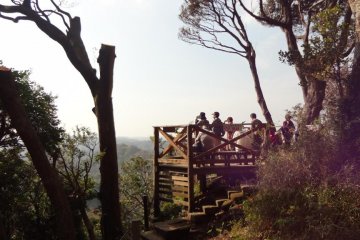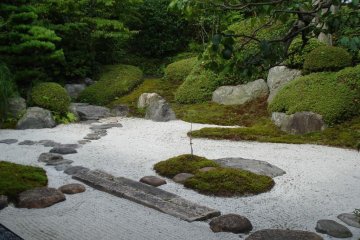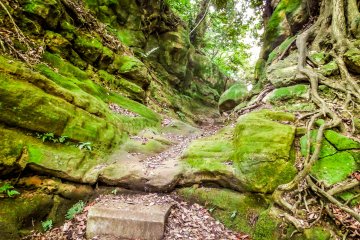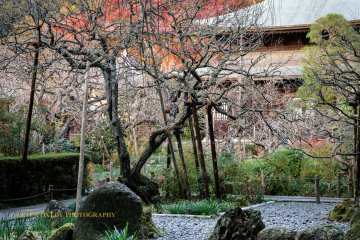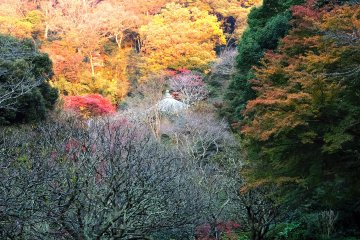Belonging to the Rinzai sect of Buddhism, Zuisenji Temple was established in 1327 by the Ashikaga family, the clan that ruled as shoguns during the Muromachi Period (1336-1573), the era that followed the Kamakura Period (1185-1333).
Temple of Flowers in the Valley of the Autumn Leaves
Zuisenji with its grounds is listed as a Place of Outstanding Scenic Beauty. It is known as the Temple of Flowers and is located in Momijigayatsu, or Valley of the Autumn Leaves, a hilly area in the northeastern reaches of the city.
Much of what we see today at Zuisenji in terms of garden design (though largely modified over the centuries) springs from the genius and creativity of one man, Muso Soseki, also known as Muso Kokushi, meaning National Zen Teacher, an honorific title conferred on him by the Emperor Go-Daigo.
Muso Soseki was the grandson of Hojo Masamura, the seventh shiken (regent) of the Kamakura Period, thus bridging the gap between two shogunates while at the same time keeping good relations with the imperial dynasty.
A Renaissance Man
Upon the downfall of the Kamakura shogunate in 1333, Muso Soseki opened the gates of Zuisenji to wounded samurai and their families who had escaped the great destruction wrought by the bloody conflict for power. The abbot and his followers personally took care of the hapless victims of war, turning the temple into a veritable field hospital.
In addition to his role as garden designer, Muso Soseki was also the founding priest of the temple, a Zen Master, a calligrapher, a poet, and a philosopher; in other words, an equivalent to a renaissance man.
Besides Zuisenji, he was also responsible for creating the gardens at Tenryu-ji and Saiho-ji (Kokedera) temples in Kyoto, both UNESCO World Heritage sites. Muso Soseki's influence on garden design continues to present-day Japan, and it is perhaps for this role that he is most remembered. He has often been called the father of the Japanese garden.
A Strolling Garden
Reconstructed in 1935, the temple’s main hall enshrines Shaka Nyorai (the historical Buddha), with Senju Kannon (a one-thousand-armed goddess) on the right, and a statue of Muso Soseki to the left.
Near the main hall is a small wooden structure called the Jizo Hall. It houses the Dokomoku Bosatsu, whose name comes from an ancient tale of an impoverished priest who sought to flee from a declining temple and was admonished in a dream by a jizo that life would be the same wherever he went, so he decided to stay. Dokomo means anywhere in English.
There are gardens at the front and the back of the temple. That at the front, after you pass through the gate at the top of the moss-covered stone steps leading up to the temple grounds, was designed as a strolling garden where numerous varieties of flowering plants and shrubs bloom throughout the seasons. Here you will see daffodils and narcissi, plum, azalea, hydrangea, anemone, and winter cherry (fuyuzakura). Add to that a moss garden and wisteria-draped trellises, under which are wooden benches provided for visitors to pause for quiet contemplation.
Rock Garden by Muso Soseki
Hidden behind the main hall lies a natural rock formation with a pond, a man-made arched bridge, a waterfall, a small island, and a cave that was once used for zazen (meditation) by resident monks as the moon’s reflection passed across the surface of the pond. Across the bridge, steps cut into the rock lead up to the Ichirantei (closed to the public), which was erected as a private hermitage of the garden's designer, Muso Soseki.
For centuries, the rock garden was believed lost, lying concealed beneath a thick layer of undergrowth; it was rediscovered and unearthed only in modern times.
A sanctuary of literary arts for monks from the five great Rinzai temples during the Kamakura era, Zuisenji is the only surviving garden from the period.
In the valley below, on the approach to the temple, the grounds and wooded hillsides are bedecked in rich red and gold foliage in autumn, delicate plum blossoms in early spring, and awash in a sea of baby blue-eyes (Nemophila) which are said to represent success, in April. It is considered a true blessing to cast your eyes on these beautiful springtime flowers.
Timeless Words of Wisdom
Muso Soseki was a prolific writer, and one of his works that caught my eye was this piece (translation attributed to W.S. Merwin), Toki-no Ge (Satori Poem), a brilliant work that puts to shame much of modern-day poetry:
Year after year I dug in the earth
looking for the blue of heaven
only to feel the pile of dirt choking me
until once in the dead of night
I tripped on a brick and kicked it into the air
and saw that without a thought
I had smashed the bones of an empty sky.
The words of the poem seem to be telling us that sometimes we are looking in the wrong place to seek what we search for. The answer might be right before our very eyes, if only we take another perspective. In other words, keep an open mind! Zen gardens were made for contemplation, inspiration, and the calming of the soul. Secluded and sequestered, Zuisenji is a place of extraordinary natural beauty, peace, and tranquility. Enjoy your visit - and take a moment for some quiet reflection of your own!



